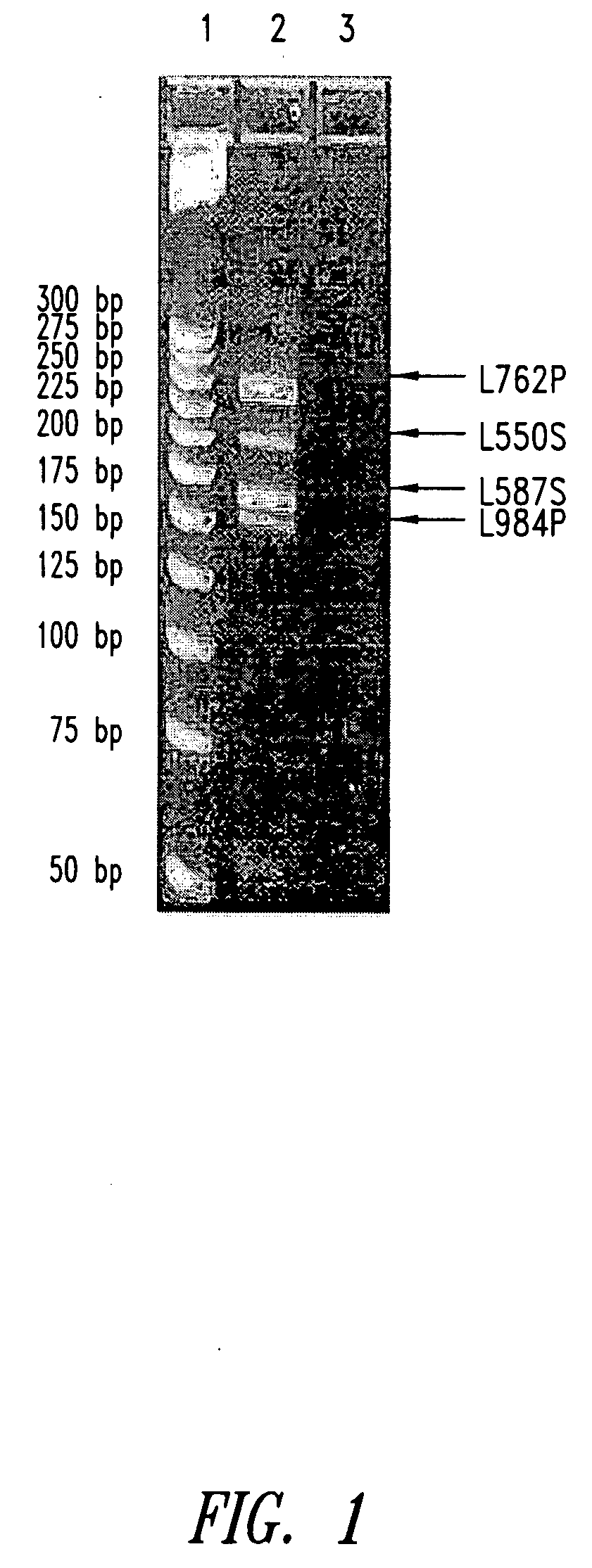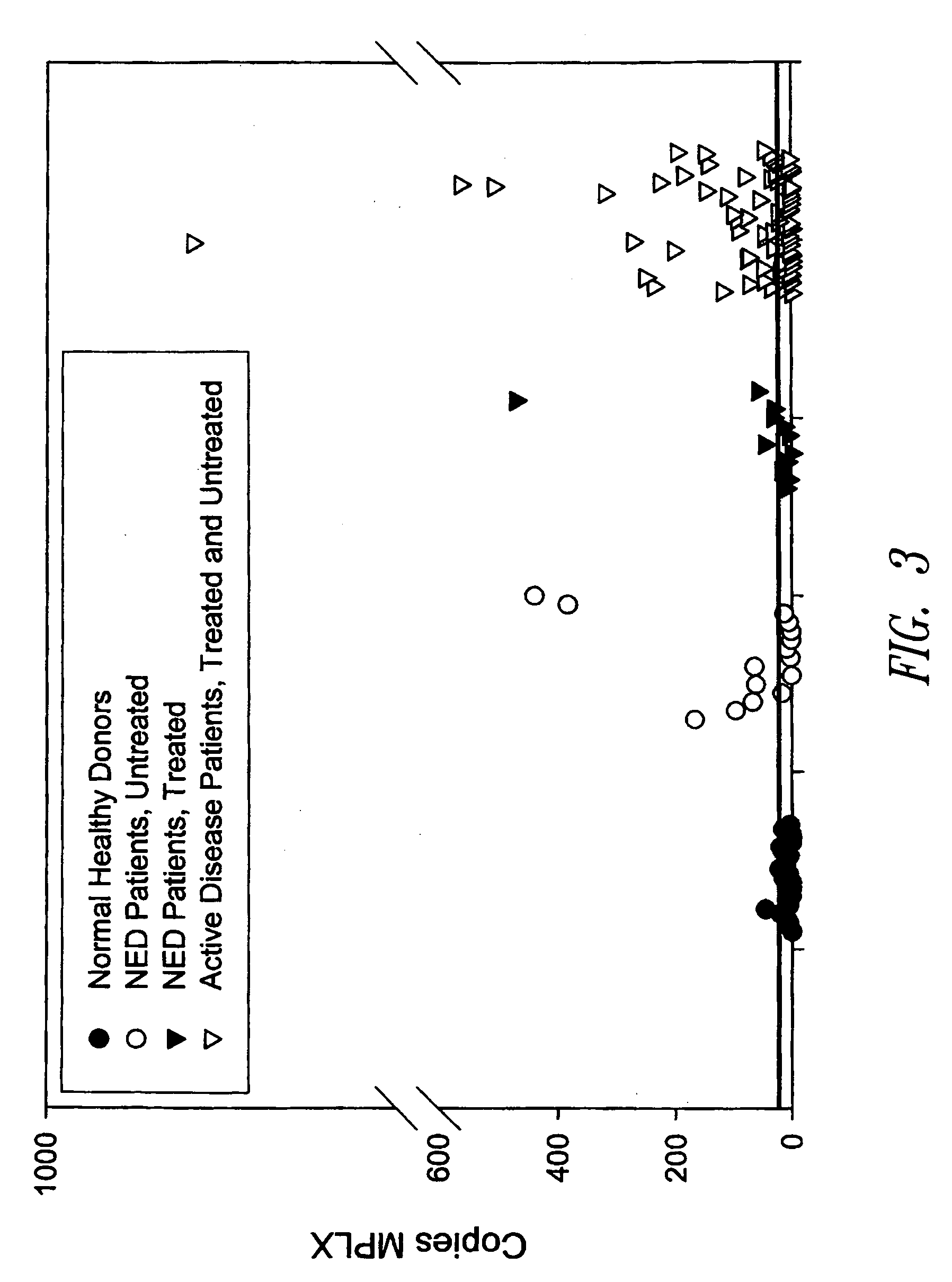Methods, compositions and kits for the detection and monitoring of lung cancer
a technology for lung cancer and compositions, applied in the field of cancer diagnostics, can solve the problems of difficult early diagnosis, high mortality rate, and elusive nscl
- Summary
- Abstract
- Description
- Claims
- Application Information
AI Technical Summary
Benefits of technology
Problems solved by technology
Method used
Image
Examples
example 1
Multiplex Detection of Lung Tumors
[0196] A Multiplex Real-time PCR assay was established in order to simultaneously detect the expression of four lung cancer-specific genes: L762 (SEQ ID NO: 1), L984 (SEQ ID NO:3), L550 (SEQ ID NO:5) and L552 (SEQ ID NO:7). In contrast to detection approaches relying on expression analysis of single lung cancer-specific genes, this Multiplex assay was able to detect all lung tumor samples tested and analyze their combined mRNA expression profile in adenocarcinoma, squamous, small cell and large cell lung tumors. L552S and L550S complement each other in detecting predominantly adenocarcinomas, L762S detects squamous cell carcinomas and L984P detects small cell carcinomas (see Table 1).
[0197] The primers and probes were designed to be intron spanning (exon specific) to eliminate any reactivity with genomic DNA making them suitable for use in blood samples without having to DNAse treat mRNA samples. They were also designed to produce amlicons of diff...
example 2
Multiplex Detection of Lung Tumors
[0202] Six additional Multiplex Real-time PCR assays were established in order to simultaneously detect the expression of various combinations of recognized lung antigens: L762 (SEQ ID NO:1), L984 (SEQ ID NO:3), L550 (SEQ ID NO:5), L552 (SEQ ID NO:7), L763 (SEQ ID NO: 21) and L587 (SEQ ID NO:26). The six groups consisted of:
[0203] Group 1: L762, L552, L550 and L984
[0204] Group 2: L763, L552, L550 and L984
[0205] Group 3: L763, L552, L587 and L984
[0206] Group 4: L763, L550, L587 and L984
[0207] Group 5: L763, L550 and L587
[0208] Group 6: L762, L984, L550 and L587
[0209] The assays were carried out described above in Example 1 to analyze the combined mRNA expression profile in lung tumors. The primers and probes for L552S, L550P, L762S, L984P are as described in Example 1. primers and probes for L763 and L587 are described below:
L763S:Forward Primer:5′ ATTCCAGGCGACATCCTCACT.(SEQ ID NO:23)Reverse Primer:5′ GTTTATCCCTGAGTCCTGTTTCCA.(SEQ ID NO:24)...
example 3
Further Characterization of Multiplex Detection Assay
A. Materials and Methods
[0213] 1. Tissue Sources and RNA Extraction
[0214] Primary cancer tissues and healthy tissues were obtained from Cooperative Human Tissue Network (CHTN), National Disease Research Interchange (NDRI), and other clinical sources. SCLC tumor cell lines were obtained from American Type Culture Collection (ATCC). Total RNA was isolated from homogenized tissue samples using TRIZOL® reagant (Invitrogen #15596-018). DNase treatment was performed using DNase I (Ambion #2222) followed by phenol / chloroform extraction and ethanol precipitation.
[0215] 2. Blood Sources and RNA Extraction
[0216] Ten milliliters peripheral blood samples were drawn from cancer patients into EDTA containing vacutainers at Swedish Medical Oncology Clinic, Seattle, Wash., and additional peripheral blood samples were obtained from ProteoGenex, Manhattan Beach, Calif. Samples were processed within three hours using RosetteSep™ tumor cell enr...
PUM
| Property | Measurement | Unit |
|---|---|---|
| Fraction | aaaaa | aaaaa |
| Fraction | aaaaa | aaaaa |
| Fraction | aaaaa | aaaaa |
Abstract
Description
Claims
Application Information
 Login to View More
Login to View More - R&D
- Intellectual Property
- Life Sciences
- Materials
- Tech Scout
- Unparalleled Data Quality
- Higher Quality Content
- 60% Fewer Hallucinations
Browse by: Latest US Patents, China's latest patents, Technical Efficacy Thesaurus, Application Domain, Technology Topic, Popular Technical Reports.
© 2025 PatSnap. All rights reserved.Legal|Privacy policy|Modern Slavery Act Transparency Statement|Sitemap|About US| Contact US: help@patsnap.com



